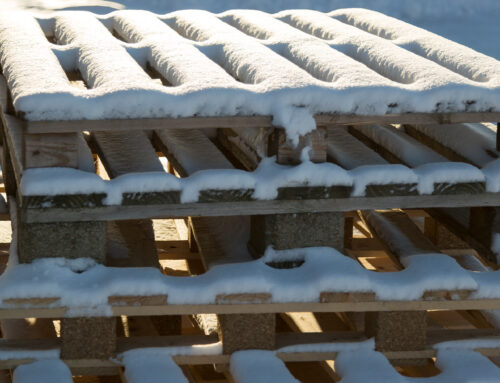Whether shipping produce, industrial goods, or cell phones, wood fasteners quite literally hold together the modern world. Although not new to the scene by any means, wood fasteners continue to play a vital role in the success of transporting goods across the country despite vast increases in technology.
Nails, screws, staples, and other wood fasteners are essential in maintaining the integrity of pallets, crates and other types of protective packaging. Choosing which wood fasteners to use may seem trivial but is equally as important.
Everyone has Strengths and Weaknesses – Even Wood Fasteners
Nails: The Classic
As far as strengths go, “bend not break” isn’t just a term used in sports. Out of all the common wood fasteners, nails are the most flexible and are less likely to split the wood than screws.
With more flexibility, and the ability to maintain the strength of wood, nails are great when dealing with joints that are susceptible to excessive shifting. Because of this, it’s common to see these type of wood fasteners used in both the framing of buildings AND the building of pallets. Both unique forms of structures are naturally prone to shifting weight.
But nails also have weaknesses. Although nails are inarguably strong, they’re not the preferred wood fasteners when it comes to dealing with excessive vertical force due to friction along the nail’s smooth cylindrical shape.
Screws: Precision Fasteners
Where nails can sometimes fall short, screws are there to save the day. With its threaded body, screws “grasp” the materials they’re placed in. Because of this added grip, the tensile strength, or ability to resist vertical pressure, is far greater than a nail.
These types of wood fasteners also vary widely in the variation of drives, or the shape on the head of the screw. Although this variation usually doesn’t affect the tensile strength of the screw, it can be used to deter dismantling or theft of an item due to the irregular shapes of the screw’s drive.
Screws that require the use of an allen wrench, for example, are much less commonly used.
On the other hand, the strong grip that screws have in materials is a double-edged sword. Although its threads increase tensile strength, they drastically decrease the flexibility of the screw. Because of this, these wood fasteners are prone to snapping when excessive horizontal shifts occur.
Screws aren’t generally the preferred wood fastener for any objects that shift weight horizontally.
Staples: Not the Kind on Your Desk
In the world of wood fasteners, staples take the cake for ease-of-use. With the introduction of the pneumatic staple gun, a tool that uses compressed air to propel staples into materials, staples have seen an increase in use nation-wide. This is especially true in the protective wood packaging industry.
These tools speed up the time of building pallets, crates, and other types of transportation packaging. With the force projected by the pneumatic staple gun, staples are less likely to damage the wood materials used in the industrial packaging industry than older methods.
On the other hand, a staple on its own can often lack the strength needed for an application, when compared to a nail or screw.
A staple’s small surface area also means that it’s vulnerable to shifting over time. Excessive force, in any direction, can decrease the integrity of the connection and the wood fastener itself.
Safety: Because Everyone Wants 10 Fingers
Needless to say, the force required to apply wood fasteners poses an obvious safety concern for the user. When applying any wood fastener, it is recommended that the user practices caution and is knowledgeable on operating this type of equipment.
Responsible for countless backyard and worksite accidents alike, using wood fastener poses a threat to untrained users, whether they’re using a hammer or a nail gun. When using any type of wood fastener tool, like a hammer or nail gun, users are encouraged to always be aware of the position of their hands – your fingers will thank you later.
Although dramatically effective, a nail gun poses the largest threat to personal safety when it comes to wood fasteners. Untrained individuals should not use nail guns, because failure to maintain caution when operating them can lead to serious injury.
Most people have stapled two pieces of paper together, but stapling wood panels into construction materials is a different story. Although not as dangerous as the nail gun, the pneumatic staple gun should be treated by users with care. Individuals should be aware of the position of their hands at all times.
Here at Conner, we make sure all our manufacturing employees are fully trained before using a nail or staple gun. It’s the kind of common sense we would expect from all manufacturers.
Less dramatic in their application, screws can be applied in a variety of ways. The two most common are using a screwdriver or power drill. When using a screwdriver, users are discouraged from using excessive downward force on the screw; other than that, just don’t screw it up!
Naturally, caution is encouraged when using any power tools, and a power drill is no different. If drilling a screw directly into a surface, eye protection is recommended as the screw’s threads will launch bits of the material up, as the screw burrows down.
Again, here at Conner, our manufacturing employees are fully trained and know the safety precautions necessary for using a drill before they every get near one. No one wants employees to get hurt.
Fastening a Conclusion
When it comes to wood fasteners, there are many kinds for many jobs. Hopefully before your next project at the plant, jobsite, or even in your backyard, you take the time to make sure that you not only have the right tool for the job, but the right fastener as well.







